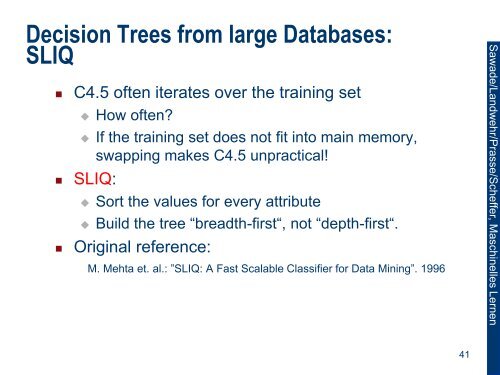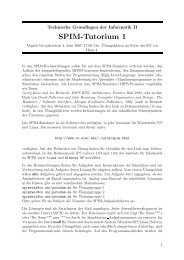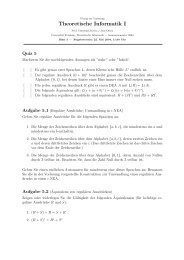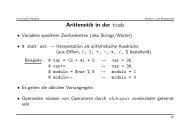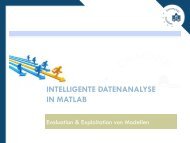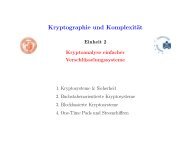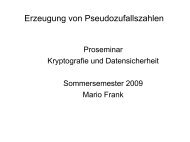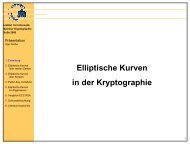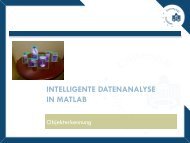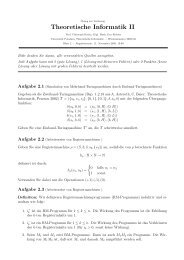Decision Trees from large Databases: SLIQ
Decision Trees from large Databases: SLIQ
Decision Trees from large Databases: SLIQ
You also want an ePaper? Increase the reach of your titles
YUMPU automatically turns print PDFs into web optimized ePapers that Google loves.
<strong>Decision</strong> <strong>Trees</strong> <strong>from</strong> <strong>large</strong> <strong>Databases</strong>:<br />
<strong>SLIQ</strong><br />
• C4.5 often iterates over the training set<br />
How often?<br />
If the training set does not fit into main memory,<br />
swapping makes C4.5 unpractical!<br />
• <strong>SLIQ</strong>:<br />
Sort the values for every attribute<br />
Build the tree “breadth-first“, not “depth-first“.<br />
• Original reference:<br />
M. Mehta et. al.: ”<strong>SLIQ</strong>: A Fast Scalable Classifier for Data Mining”. 1996<br />
Sawade/Landwehr/Prasse/Scheffer, Maschinelles Lernen<br />
41
<strong>SLIQ</strong>: Gini Index<br />
• To determine the best split, <strong>SLIQ</strong> uses the Gini-<br />
Index instead of Information Gain.<br />
• For a training set L with n distinct classes:<br />
Gini L = 1 − p j<br />
2<br />
j=1…n<br />
p j is the relative frequency of value j<br />
• After a binary split of the set L into sets L 1 and L 2<br />
the index becomes:<br />
Gini split L = L 1<br />
L Gini L 1 + L 2<br />
L Gini L 2<br />
• Gini-Index behaves similarly to Information Gain.<br />
Sawade/Landwehr/Prasse/Scheffer, Maschinelles Lernen<br />
42
Compare: Information Gain vs. Gini Index<br />
• Which split is better?<br />
[29 +, 35 -]<br />
yes<br />
x 1<br />
x 2<br />
no<br />
• H L, y = − 29<br />
64 log 2 29<br />
64 + 35<br />
64 log 2 35<br />
64<br />
= 0.99<br />
[29 +, 35 -]<br />
[21+, 5 -] [8+, 30 -] [18+, 33 -] [11+, 2 -]<br />
• IG L, x 1 = 0.99 − 26<br />
64 H L x 1 =yes, y + 38<br />
64 H L x 1 =no, y ≈ 0.26<br />
• IG L, x 2 = 0.99 − 51<br />
64 H L x 2 =yes, y + 13<br />
64 H L x 2 =no, y ≈ 0.11<br />
1 − 8 38<br />
• Gini x1 L = 26<br />
64 Gini L x 1 =yes + 38<br />
64 Gini L x 1 =no ≈ 0.32<br />
• Gini x2 L = 51<br />
64 Gini L x 2 =yes + 13<br />
64 Gini L x 2 =no ≈ 0.42<br />
43<br />
yes<br />
2<br />
+<br />
30<br />
38<br />
2<br />
no<br />
≈ 0.33<br />
Sawade/Landwehr/Prasse/Scheffer, Maschinelles Lernen
<strong>SLIQ</strong> – Algorithm<br />
1. Start Pre-sorting of the samples.<br />
2. As long as the stop criterion has not been reached<br />
1. For every attribute<br />
1. Place all nodes into a class histogram.<br />
2. Start evaluation of the splits.<br />
2. Choose a split.<br />
3. Update the decision tree; for each new node<br />
update its class list (nodes).<br />
Sawade/Landwehr/Prasse/Scheffer, Maschinelles Lernen<br />
44
<strong>SLIQ</strong> (1st Substep)<br />
• Pre-sorting of the samples:<br />
1. For each attribute: create an attribute list with<br />
columns for the value, sample-ID and class.<br />
2. Create a class list with columns for the sample-ID,<br />
class and leaf node.<br />
3. Iterate over all training samples:<br />
<br />
For each attribute<br />
<br />
<br />
Insert its attribute values, sample-ID and class (sorted<br />
by attribute value) into the attribute list.<br />
Insert the sample-ID, the class and the leaf node<br />
(sorted by sample-ID) into the class list.<br />
Sawade/Landwehr/Prasse/Scheffer, Maschinelles Lernen<br />
45
<strong>SLIQ</strong>: Example<br />
Sawade/Landwehr/Prasse/Scheffer, Maschinelles Lernen<br />
46
<strong>SLIQ</strong>: Example<br />
Sawade/Landwehr/Prasse/Scheffer, Maschinelles Lernen<br />
47
<strong>SLIQ</strong> – Algorithm<br />
1. Start Pre-sorting of the samples.<br />
2. As long as the stop criterion has not been reached<br />
1. For every attribute<br />
1. Place all nodes into a class histogram.<br />
2. Start evaluation of the splits.<br />
2. Choose a split.<br />
<br />
3. Update the decision tree; for each new node<br />
update its class list (nodes).<br />
Sawade/Landwehr/Prasse/Scheffer, Maschinelles Lernen<br />
48
<strong>SLIQ</strong> (2nd Substep)<br />
• Evaluation of the splits.<br />
1. For each node, and for all attributes<br />
1. Construct a histogram (for each class the histogram<br />
saves the count of samples before and after the<br />
split).<br />
2. For each attribute A<br />
1. For each value v (traverse the attribute list for A)<br />
1. Find the entry in the class list (provides the class and<br />
node).<br />
2. Update the histogram for the node.<br />
3. Assess the split (if its a maximum, record it!)<br />
Sawade/Landwehr/Prasse/Scheffer, Maschinelles Lernen<br />
49
<strong>SLIQ</strong>: Example<br />
Sawade/Landwehr/Prasse/Scheffer, Maschinelles Lernen<br />
50
<strong>SLIQ</strong> – Algorithm<br />
1. Start Pre-sorting of the samples.<br />
2. As long as the stop criterion has not been reached<br />
1. For every attribute<br />
1. Place all nodes into a class histogram.<br />
2. Start evaluation of the splits.<br />
2. Choose a split.<br />
<br />
<br />
3. Update the decision tree; for each new node<br />
update its class list (nodes).<br />
Sawade/Landwehr/Prasse/Scheffer, Maschinelles Lernen<br />
51
<strong>SLIQ</strong> (3rd Substep)<br />
• Update the Class list (nodes).<br />
1. Traverse the attribute list of the attribute used in<br />
the node.<br />
2. For each entry (value, ID)<br />
3. Find the matching entry (ID, class, node) in the<br />
class list.<br />
4. Apply the split criterion emitting a new node.<br />
5. Replace the corresponding class list entry with (ID,<br />
class, new node).<br />
Sawade/Landwehr/Prasse/Scheffer, Maschinelles Lernen<br />
52
<strong>SLIQ</strong>: Example<br />
Sawade/Landwehr/Prasse/Scheffer, Maschinelles Lernen<br />
53
<strong>SLIQ</strong>: Data Structures<br />
• Data structures in memory?<br />
• Swappable data structures?<br />
• Data structures in a database?<br />
Sawade/Landwehr/Prasse/Scheffer, Maschinelles Lernen<br />
54
<strong>SLIQ</strong>- Pruning<br />
• Minimum Description Length (MDL): the best model<br />
for a given data set minimizes the sum of the length<br />
the encoded data by the model plus the length of<br />
the model.<br />
cost M, D = cost D M + cost M<br />
• cost M = cost of the model (length).<br />
How <strong>large</strong> is the decision tree?<br />
• cost D M = cost to describe the data with the<br />
model.<br />
How many classification errors are incurred?<br />
Sawade/Landwehr/Prasse/Scheffer, Maschinelles Lernen<br />
55
Pruning – MDL Example I<br />
• Assume: 16 binary attributes and 3 classes<br />
• cost M, D = cost D M + cost M<br />
Cost for the encoding of an internal node:<br />
log 2 (m) = log 2 16 = 4<br />
Cost for the encoding of a leaf:<br />
log 2 (k) = log 2 (3) = 2<br />
Cost for the encoding of a classification error for n<br />
training data points:<br />
log 2 (n)<br />
7 Errors<br />
C 1<br />
C 2<br />
C 3<br />
Sawade/Landwehr/Prasse/Scheffer, Maschinelles Lernen<br />
56
Pruning – MDL Example II<br />
• Which tree is better?<br />
7 Errors<br />
Tree 1: Tree 2:<br />
C 1<br />
C 1<br />
C 2 C 3<br />
Internal nodes Leaves Errors<br />
4 Errors<br />
C 2<br />
C 1 C 2<br />
• Cost for tree 1: 2 ∗ 4 + 3 ∗ 2 + 7 ∗ log 2 n = 14 + 7 log 2 n<br />
• Cost for tree 2: 4 ∗ 4 + 5 ∗ 2 + 4 ∗ log 2 n = 26 + 4 log 2 n<br />
• If n < 16, then tree 1 is better.<br />
• If n > 16, then tree 2 is better.<br />
C 3<br />
Sawade/Landwehr/Prasse/Scheffer, Maschinelles Lernen<br />
57
<strong>SLIQ</strong> – Properties<br />
• Running time for the initialization (pre-sorting):<br />
O n log n for each attribute<br />
• Much of the data must not be kept in main memory.<br />
• Good scalability.<br />
If the class list does not fit in main memory then <strong>SLIQ</strong><br />
no longer works.<br />
Alternative: SPRINT<br />
• Can handle numerical and discrete attributes.<br />
• Parallelization of the process is possible.<br />
Sawade/Landwehr/Prasse/Scheffer, Maschinelles Lernen<br />
58
Regression <strong>Trees</strong><br />
• ID3, C4.5, <strong>SLIQ</strong>: Solve classification problems.<br />
Goal: low error rate + small tree<br />
• Attribute can be continuous (except for ID3), but<br />
their prediction is discrete.<br />
• Regression: the prediction is continuously valued.<br />
Goal: low quadratic error rate + simple model.<br />
n<br />
2<br />
SSE = j=1 y j − f x j<br />
• Methods we will now examine:<br />
Regression trees,<br />
Linear Regression,<br />
Model trees.<br />
Sawade/Landwehr/Prasse/Scheffer, Maschinelles Lernen<br />
59
Regression <strong>Trees</strong><br />
• Input: L = x 1 , y 1 , … , x n , y n , continuous y.<br />
• Desired result: f: X → Y<br />
• Algorithm CART<br />
It was developed simultaneously & independently<br />
<strong>from</strong> C4.5.<br />
Terminal nodes incorporate continuous values.<br />
Algorithm like C4.5. For classification, there are<br />
slightly different criteria (Gini instead of IG), but<br />
otherwise little difference.<br />
Information Gain (& Gini) only work for classification.<br />
Question: What is a split criterion for Regression?<br />
• Original reference:<br />
L. Breiman et. al.: ”Classification and Regression <strong>Trees</strong>”. 1984<br />
Sawade/Landwehr/Prasse/Scheffer, Maschinelles Lernen<br />
60
Regression <strong>Trees</strong><br />
• Goal: small quadratic error (SSE) + small tree.<br />
• Examples L arrive at the current node.<br />
• SSE at the current node: SSE L = x,y ∈L y − y 2<br />
where y = 1 y<br />
L x,y ∈L .<br />
• With which test should the data be split?<br />
• Criterion for test nodes x ≤ v :<br />
SSE − Red L, x ≤ v = SSE L − SSE L x≤v − SSE L x>v<br />
SSE-Reduction through the test.<br />
• Stop Criterion:<br />
Do not make a new split unless the SSE will be<br />
reduced by at least some minimum threshold.<br />
Sawade/Landwehr/Prasse/Scheffer, Maschinelles Lernen<br />
If so, then create a terminal node with mean m of L.<br />
61
CART- Example<br />
• Which split is better?<br />
L = [2,3,4,10,11,12]<br />
SSE L = 100<br />
ja<br />
nein<br />
SSE L = y − y 2<br />
x,y ∈L where y = 1 L<br />
x 1<br />
x 2<br />
L = [2,3,4,10,11,12]<br />
ja<br />
nein<br />
L 1 = [2,3] L 2 =[4,10,11,12] L 1 =[2,4,10] L 2 =[3,11,12]<br />
SSE L 1 = 0,5 SSE L 2 = 38,75 SSE L 1 = 34,67 SSE L 2 = 48,67<br />
x,y ∈L<br />
y<br />
Sawade/Landwehr/Prasse/Scheffer, Maschinelles Lernen<br />
62
Linear Regression<br />
• Regression trees: constant prediction at every leaf<br />
node.<br />
• Linear Regression: Global model of a linear<br />
dependence between x and y.<br />
• Standard method.<br />
• Useful by itself and it serves as a building block for<br />
Model trees.<br />
Sawade/Landwehr/Prasse/Scheffer, Maschinelles Lernen<br />
63
Linear Regression<br />
• Input: L = x 1 , y 1 , … , x n , y n<br />
• Desired result: a linear model, f x = w T x + c<br />
Normal vector<br />
Residuals<br />
Points along the<br />
Regression line<br />
are perpendicular<br />
to the normal vector.<br />
Sawade/Landwehr/Prasse/Scheffer, Maschinelles Lernen<br />
64
Model <strong>Trees</strong><br />
• <strong>Decision</strong> trees but with a linear regression model at<br />
each leaf node.<br />
Sawade/Landwehr/Prasse/Scheffer, Maschinelles Lernen<br />
.2 .3 .4 .5 .6 .7 .8 .9 1.0 1.1 1.2 1.3<br />
65
Model <strong>Trees</strong><br />
• <strong>Decision</strong> trees but with a linear regression model at<br />
each leaf node.<br />
yes ja<br />
yes ja<br />
x < .9<br />
x < .5 x < 1.1<br />
no nein<br />
yes<br />
no nein<br />
nein no<br />
Sawade/Landwehr/Prasse/Scheffer, Maschinelles Lernen<br />
.1 .2 .3 .4 .5 .6 .7 .8 .9 1.0 1.1 1.2 1.3<br />
66
Model <strong>Trees</strong>: Creation of new Test Nodes<br />
• Fit a linear regression of all samples that are filtered<br />
to the current node.<br />
• Compute the regression‘s SSE.<br />
• Iterate over all possible tests (like C4.5):<br />
Fit a linear regression for the subset of samples on<br />
the left branch, & compute SSE left .<br />
Fit a linear regression for the subset of samples on<br />
the right branch, & compute SSE right .<br />
• Choose the test with the <strong>large</strong>st reduction<br />
SSE − SSE left − SSE right .<br />
• Stop-Criterion: If the SSE is not reduced by at least<br />
a minimum threshold, don‘t create a new test.<br />
Sawade/Landwehr/Prasse/Scheffer, Maschinelles Lernen<br />
67
Missing Attribute Values<br />
• Problem: Training data with missing attributes.<br />
• What if we test an attribute A for which an attribute<br />
value does not exist for every sample?<br />
These training samples receive a substitute attribute<br />
value which occurs most frequently for A among the<br />
samples at node n.<br />
These training samples receive a substitute attribute<br />
value, which most samples with the same<br />
classification have.<br />
Sawade/Landwehr/Prasse/Scheffer, Maschinelles Lernen<br />
68
Attributes with Costs<br />
• Example: Medical diagnosis<br />
A blood test costs more than taking one‘s pulse<br />
• Question: How can you learn a tree that is<br />
consistent with the training data at a low cost?<br />
• Solution: Replace Information Gain with:<br />
Tan and Schlimmer (1990):<br />
Nunez (1988):<br />
IG 2 L,x<br />
Cost A<br />
2 IG L,x −1<br />
Cost A +1 w<br />
Parameter w ∈ 0,1 controls the impact of the cost.<br />
Sawade/Landwehr/Prasse/Scheffer, Maschinelles Lernen<br />
69
Bootstrapping<br />
• Simple resampling method.<br />
• Generates many variants of a training set L.<br />
• Bootstrap Algorithm:<br />
Repeat k = 1 … M times:<br />
Generate a sample dataset L k of size n <strong>from</strong> L:<br />
• The sampled dataset is drawn uniformly with<br />
replacement <strong>from</strong> the original set of samples.<br />
Compute model θ k for dataset L k<br />
Return the parameters generated by the bootstrap:<br />
θ ∗ =<br />
θ 1 , … , θ M<br />
Sawade/Landwehr/Prasse/Scheffer, Maschinelles Lernen<br />
70
Bootstrapping - Example<br />
x =<br />
3.12<br />
0<br />
1.57<br />
19.67<br />
0.22<br />
2.20<br />
, x = 4,46<br />
x =<br />
x =<br />
x =<br />
1.57<br />
0.22<br />
19.67<br />
0<br />
0.22<br />
3.12<br />
0<br />
2.20<br />
19.67<br />
2.20<br />
2.20<br />
1.57<br />
0.22<br />
3.12<br />
1.57<br />
3.12<br />
2.20<br />
0.22<br />
, x = 4,13<br />
, x = 4,64<br />
, x = 1,74<br />
71<br />
Sawade/Landwehr/Prasse/Scheffer, Maschinelles Lernen
Bagging – Learning Robust <strong>Trees</strong><br />
• Bagging = Bootstrap aggregating<br />
• Bagging – Algorithm:<br />
Repeat k = 1 … M times :<br />
Generate a sample dataset L k <strong>from</strong> L.<br />
Compute model θ k for dataset L k .<br />
• Combine the M learned predictive models:<br />
Classification problems: Voting<br />
Regression problems: Mean value<br />
• Original reference:<br />
L.Breiman: “Bagging Predictors”. 1996<br />
e.g. a model tree<br />
Sawade/Landwehr/Prasse/Scheffer, Maschinelles Lernen<br />
72
Random Forests<br />
• Repeat:<br />
Draw randomly n samples, uniformly with<br />
replacement, <strong>from</strong> the training set.<br />
Randomly select m ′ < m features<br />
Learn decision tree (without pruning)<br />
• Classification: Maximum over all trees (Voting)<br />
• Regression: Average over all trees<br />
• Original reference:<br />
L. Breiman: ”Random Forests”. 2001<br />
Bootstrap<br />
Sawade/Landwehr/Prasse/Scheffer, Maschinelles Lernen<br />
73
Usages of <strong>Decision</strong> <strong>Trees</strong><br />
• Medical Diagnosis.<br />
• In face recognition.<br />
• As part of more complex systems.<br />
Sawade/Landwehr/Prasse/Scheffer, Maschinelles Lernen<br />
74
<strong>Decision</strong> Tree - Advantages<br />
• Easy to interpret.<br />
• Can be efficiently learned <strong>from</strong> many samples.<br />
<strong>SLIQ</strong>, SPRINT<br />
• Many Applications.<br />
• High Accuracy.<br />
Sawade/Landwehr/Prasse/Scheffer, Maschinelles Lernen<br />
75
<strong>Decision</strong> Tree - Disadvantages<br />
• Not robust against noise<br />
• Tendency to overfit<br />
• Unstable<br />
Sawade/Landwehr/Prasse/Scheffer, Maschinelles Lernen<br />
76
Summary of <strong>Decision</strong> <strong>Trees</strong><br />
• Classification: Prediction of discrete values.<br />
Discrete attributes: ID3.<br />
Continuous attributes: C4.5.<br />
Scalable to <strong>large</strong> databases: <strong>SLIQ</strong>, SPRINT.<br />
• Regression: Prediction of continuous values.<br />
Regression trees: constant value predicted at each<br />
leaf.<br />
Model trees: a linear model is contained in each leaf.<br />
Sawade/Landwehr/Prasse/Scheffer, Maschinelles Lernen<br />
77


